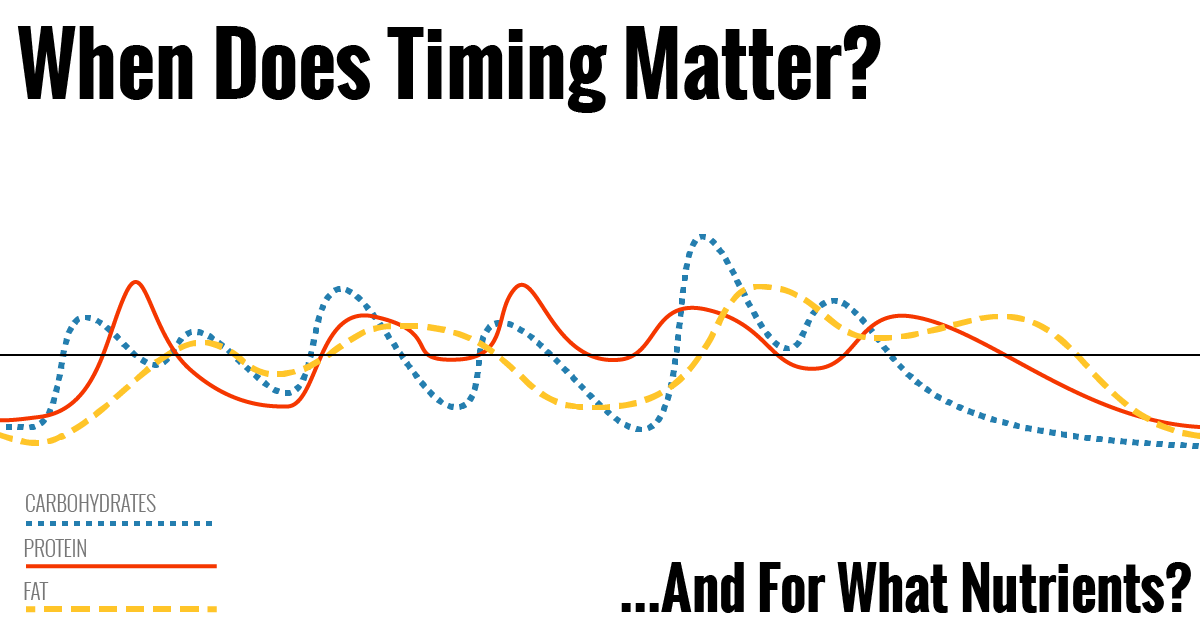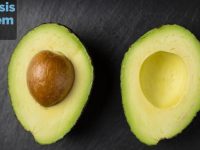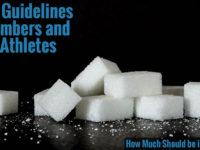When does timing matter? Ten years ago, nutrient timing was huge; entire nutrition philosophies arose from the idea that there were “windows” when certain nutrients were more or less important. Today, accumulating evidence suggests this isn’t true—but timing as a concept isn’t quite dead.
There are times and situations when timing matters. More specifically, there are macronutrients that are more or less important to time. A lot of time can be wasted on pursuing useless strategies, but there is also potential to boost performance and improve recovery.
In this article, we’ll take an in-depth look at when timing matters, and for what macronutrients. We’ll start with the highest priority nutrient—carbohydrates—and move down the line from there. Let’s begin.
High-Priority Timing: Carbohydrates
Relative to the other macronutrients, carbohydrates have the highest priority. Carbs have the unique position of being both an important endogenous fuel source—i.e., our in-house stores of muscle and liver glycogen—as well as an important exogenous one, that is, any carb-containing food we eat during or in the hours before exercise. Of all the macronutrients, only carbohydrates are considered ergogenic, or exercise-improving.
We can separate our daily carbohydrates into two distinct pools:
- Baseline Carbohydrates: These are the carbohydrates we eat every day regardless of exercise. They may occasionally bolster muscle glycogen stores, but by and large they are just “generic calories” and serve to fuel our basal metabolic functions. This pool is the same size day-to-day.
- Exercise Carbohydrates: These are the carbohydrates consumed explicitly to fuel and recover from exercise. The size of this pool depends on exercise duration and intensity.
Baseline Carbohydrate Intake
For baseline carbohydrates, I hesitate to endorse any single eating pattern. I hesitate because carbohydrates—unlike protein—don’t have a threshold to be “maximally effective”; if you eat 10 grams or 100 grams, you’ll use 100%. And while there may be some small advantage of one pattern or another in certain cases or for certain people (e.g., equal spreading, back-loading, IF, etc.), there isn’t enough scientific evidence to support one over the rest. In terms of habits, it appears when you consume your daily carbs is unimportant.
That being said, if you don’t already have a preferred carbohydrate schedule, I recommend spreading them out relatively evenly amongst all your meals and snacks. At the very least, this will help you avoid harsh spikes after carbohydrate-rich meals (especially if those carbs less complex) and subsequent dips in energy afterwards.
Assuming you consume a normal amount of carbohydrates every day (45% or more of daily calories), the optimal scenario is to store or use 100% of the carbohydrates we consume. This means 80-100 grams in the liver as glycogen, topping off the muscles (which should be full based on exercise carbs; more on that next), and then using the few remaining carbs immediately for energy before letting liver glycogen provide a trickle for the next 3-5 hours.
When we concentrate all our carbs into only a couple meals, however, it becomes challenging to get all of your carbohydrates—often 300 grams or more—without also creating large energy spikes. This energy spike encourages the body to store the dietary fat we consumed (or in the absence of fat and the extreme surplus of carbs, transform carbs into fat to store). In the energy dip that follows, you will pull that fat back out to provide energy, but efficiency is compromised.
Here’s a graph demonstrating these harsh spikes and dips:
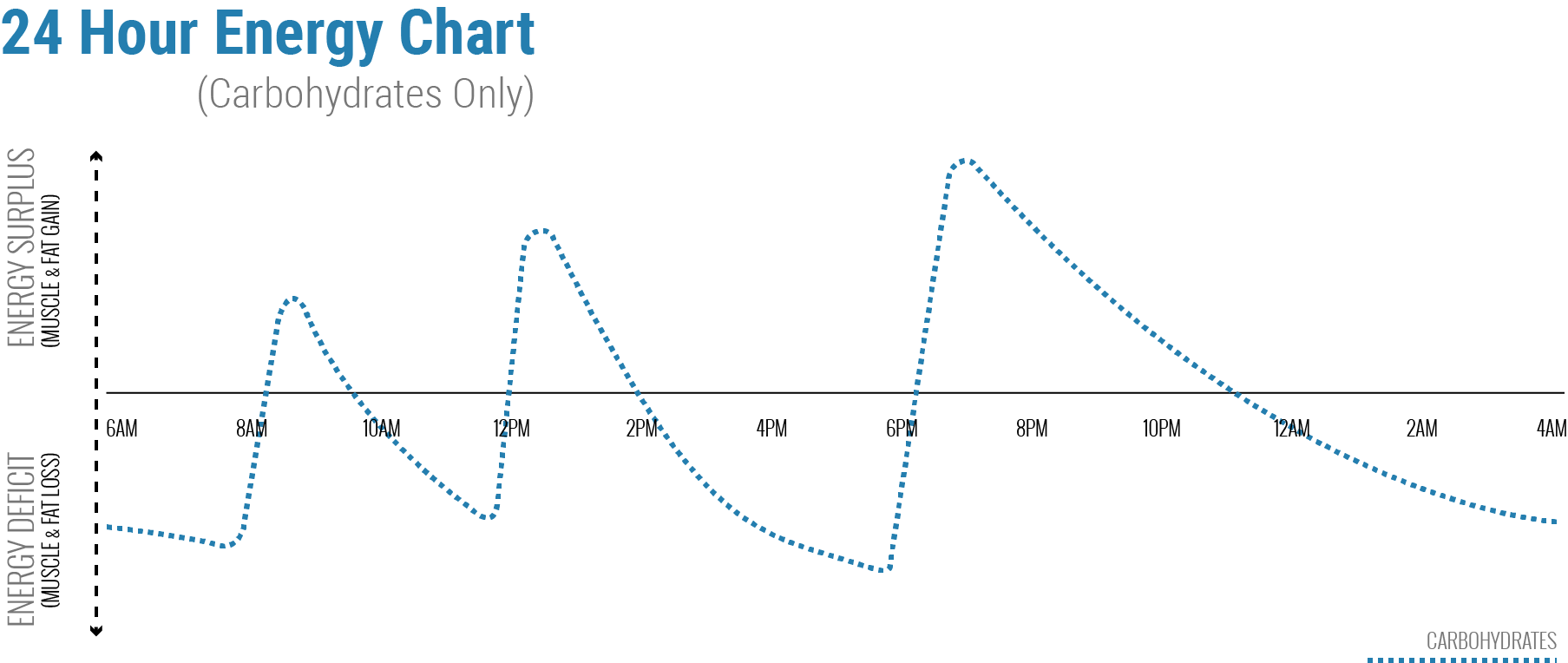
Is this definitely a problem? Not necessarily, and certainly many people consume this sort of diet and do fine; in the end, total daily calories matter more for weight gain or loss than anything else. However, some research suggests that athletes whose diets lead to greater amounts of time in an energy deficit are more likely to have greater amounts of body fat—in other words, assuming equal caloric intakes, athletes who consume more frequent, smaller meals tend to be leaner.
If this hypothesis is borne out, the most plausible reason for why is lost efficiency: we can only store fat in one place, but we can (and do) pull energy from multiple pools. If we need to bolster our blood glucose—a reasonable assumption for an athlete who eats infrequently—we can’t use fat, we can only use amino acids pulled from the muscle (gluconeogenesis). In a single day, this won’t change much, but across many days it could shift body composition slightly more towards fat and less towards muscle.
The other thing to consider is that muscle protein synthesis (useful for both muscle gain and recovery) caps whereas fat gain does not; a caloric surplus of 100 calories and of 500 calories will encourage equal amounts of muscle gain, but the latter will contribute much more to fat gain. If muscle gain and recovery are our primary goals, then we’re encouraged to spend more time in a caloric surplus but to have relatively less “area under the curve” for the surplus—we want to keep our surpluses as close to equilibrium as possible without ending up in a caloric deficit. That means more, smaller peaks and valleys.
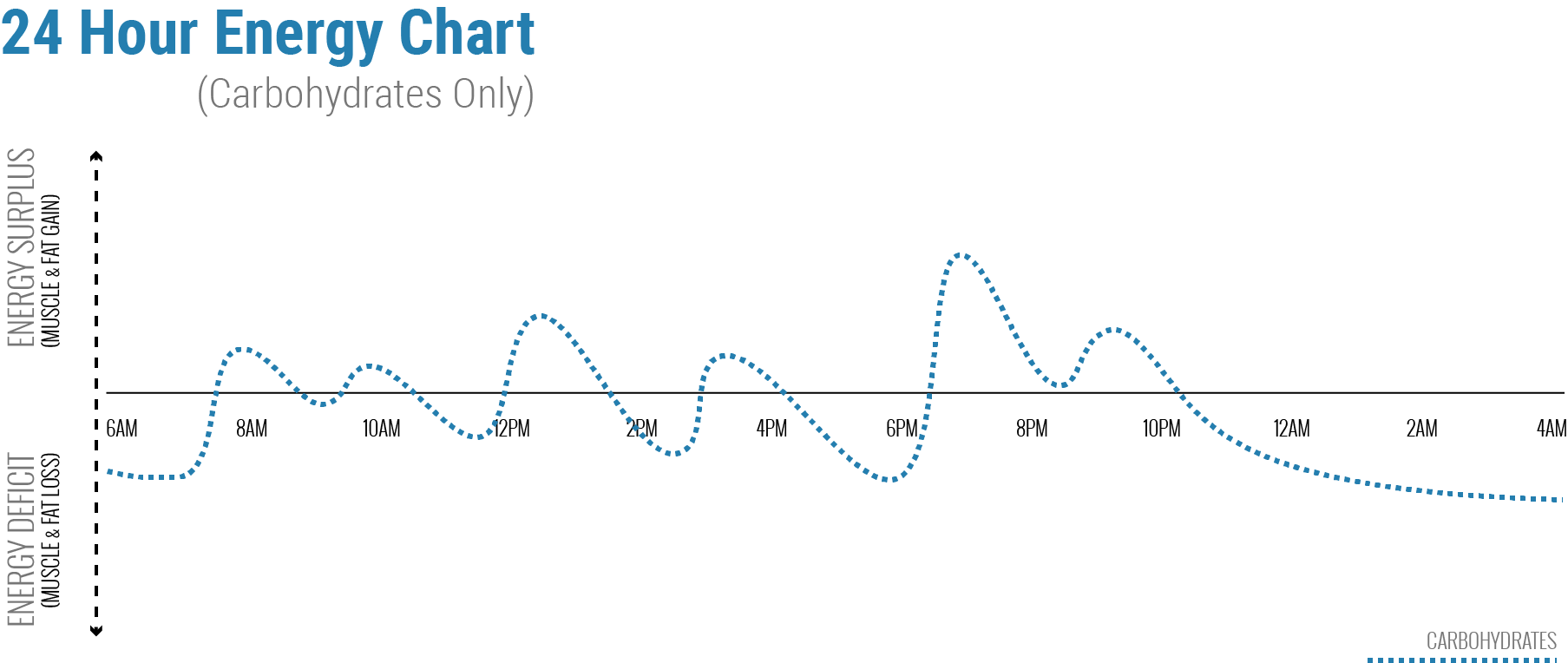
In the graph above we have more surplus spikes, but since those surpluses are smaller we’re less likely to store excess calories as fat and have less need to pull calories from fat later, increasing efficiency. Muscle gain and recovery are also encouraged by the increased number of spikes, leading to equal or better muscle anabolism without encouraging fat anabolism (e.g., fat gain).
But! As I said, if you already adhere to a specific eating schedule—and it’s working for you—then there isn’t strong evidence you should change it. In general, I would only recommend a major dietary change like a dietary schedule shift if there was strong evidence to support it or if a person’s current habits aren’t supporting them. We don’t have strong evidence in this case, only a hypothesis and some weak evidence to support it. It’s enough for me to say “go for it” if you don’t have a plan or your plan isn’t working, but otherwise, hold back.
Carbohydrates During & Around Exercise
Okay, so the evidence for timing your daily carbohydrates in a special way is weak; the same cannot be said for timing carbohydrates around exercise. Carbohydrates both internal (glycogen) and external (food) increase exercise performance. In fact, carbohydrates have been called the world’s most potent ergogenic aid due to their efficacy, effectiveness, and strength of evidence!
The main goal with timing carbs around exercise is ensuring you have an adequate amount to keep blood glucose from dipping. If you exercise for only a short period of time, your muscle and liver glycogen is likely enough. If you exercise for 2 hours or longer, you might benefit from adding some external source, whether food consumed in the two hours prior to exercise or some simple sugars consumed during exercise. Regardless, all carbohydrates—whether the glycogen in your muscles or the sugars in your foods—are in addition to the carbohydrates you consume at baseline.
For example, if you climb for an hour and a half at the gym, you might use 60-90 grams of glycogen which you’ll want to replace after exercise by consuming an additional 60-90 grams of carbs in the hours afterwards. If you hike up to a crag at 7AM, climb for 10 hours, and hike back down, you’ll want to consume a potential extra 300-600 grams of carbohydrate across your day, with most of them coming during the climbing session itself because you simply don’t have enough glycogen to maintain a performance advantage without a continuous flow of external carbs. In both cases, those are carbs you’re consuming on top of whatever carbs you need at baseline—if you don’t replace them (or if you replace them with fat), you’ll lose performance.
How much carbohydrate do you need per hour of climbing? It’s difficult to pinpoint a single value, but one study found that overall energy use while climbing (indoors) was approximately 14-17 kcal per minute on the wall, with the lower figure representing easy climbing (for your ability) and the higher figure representing difficult climbing. Assuming you’re actually “on the wall” about 20 minutes of every hour, that means climbing burns about 300 kcal an hour—the equivalent to 75 grams of carbohydrates. In practice, you’ll also burn fat, so a better estimation is that we need 45-60 grams of carbohydrates per hour of climbing (depending on difficulty).
Exactly when you get these extra carbs will depend on how long you exercise for, but in general there are three “windows” around exercise where carbs can help:
- Up to 2 Hours Before Exercise. In this time period, slower carbohydrates (e.g., whole grains, legumes, root vegetables, etc.) are best because they will release their energy in a trickle during exercise. Avoid carbohydrates that cause stomach upset and quick carbohydrates that will be fully digested and absorbed before exercise begins (e.g., simple sugars).
- During Exercise. During exercise, rapidly released carbohydrates are your best bet. Whole food-wise, fruits are your best bet, but even simpler carbs such as those found in sports drinks (or gels, etc.) will ensure the energy you ingest is absorbed and usable prior to the finish of exercise.
- After Exercise. After exercise, your choices are open. Fast-digesting carbs will immediately start to replenish your muscle and liver glycogen, but there’s no time pressure here—as long as you’re not exercising again within the next 12 hours, you’re all but guaranteed to restock your glycogen stores assuming you eat enough carbohydrates. For this reason, slower carbs are great choices (and also healthier ones).
The additional carbs you consume can come during any one of these time periods. If you consume carbohydrates during or before exercise, you will reduce glycogen use (link)(there is some debate about how much and in what circumstances).* If you consume carbs after exercise, you’ll replenish your depleted glycogen stores. All are in addition to whatever carbs you consume throughout the rest of your day.
*Some studies suggest external carbs don’t spare glycogen, but it seems like this is mostly true when energy need is so high that the external carbs are simply used in addition to muscle glycogen to fuel sport—for example, in cycling, where energy needs can be extreme. For a sport like climbing, I would expect external carbs to at least modestly decrease during-exercise glycogen use.
Carbohydrate Timing Recap
The main focus for carbohydrates is timing during and around exercise. While there may be a small advantage to be gained from spreading your daily baseline carbohydrates out evenly—and this is something I recommend when a person’s eating habits or schedule otherwise aren’t working—there’s not enough evidence to suggest everyone should make this change.
After accounting for baseline carbohydrate needs (you can read a bit about that here, depending on the type of climber you are), any additional carbohydrates you need should come in the windows surrounding exercise and in an amount commensurate with the amount and type of exercise you’re engaged in. The basic idea is to replace whatever carbohydrates (and calories) you’ve burned.
Compared to the other macronutrients, carbohydrates offer the greatest benefit for timing as they increase performance in-the-moment. Neither protein nor fat has this capability, and so they are prioritized less highly.
Medium-Priority Timing: Protein
I’ve written a lot about protein (here and here, for example); much of what I would say in this section would just be rehashing the subject yet again. I don’t think there’s a reason to do that when I’ve already written more on-point articles on the topic. Instead, I’m only going to write a bit about why protein falls into the “medium-priority” area.
Is timing protein important? Definitely. It’s clear that spreading protein between a few meals is better than clustering all your protein in one meal or at only one time of day. Our muscles respond better to having more overall access to amino acids (derived from dietary protein) rather than closeting that access to only a few hours out of every 24.
Does timing protein have measurable, immediate effects? Only if you have access to a lab that would allow you to measure muscle protein synthesis. Certainly there’s no short-term performance benefit, and even the long-term benefit is clouded by the myriad ways a person can train and the near-infinite diets a person can consume.
There’s also no advantage to timing protein around exercise—that’s a long-debunked myth. There’s no “post-exercise” recovery window you have to cram protein into, so long as your overall daily intake is adequate.
In the context of the day, there are only really two important rules:
- Consume at least 20 grams of high-quality protein (or a relatively larger amount of mixed high- and medium-quality proteins) per meal. 20 grams is the threshold for maximally triggering muscle protein synthesis—greater amounts do little extra—and consuming this amount will ensure you get maximum benefit.
- Spread your meals out by around 3 hours. It takes about 3 hours for our muscles to become receptive to protein again after being triggered, so consuming two high-protein meals within an hour of each other won’t be as effective.
Past this, there’s less consensus about exactly how many meals we need to get the most out of protein. Hypothetically, we could consume some form of protein eight times a day (this would require waking up twice in the middle of the night to drink a protein shake), but no one recommends that and there’s no evidence it would do anything beneficial. More realistically, most people can consume five or six high-protein meals a day, but even this might have minimal extra benefit over consuming four meals. My own recommendation is to try to get at least three, but preferably four high-protein meals per day. If you’re motivated or don’t find it inconvenient, then aim for five—but if this isn’t realistic, then don’t sweat it.
Since I included a graph with carbohydrates, I’ll include one for protein as well:
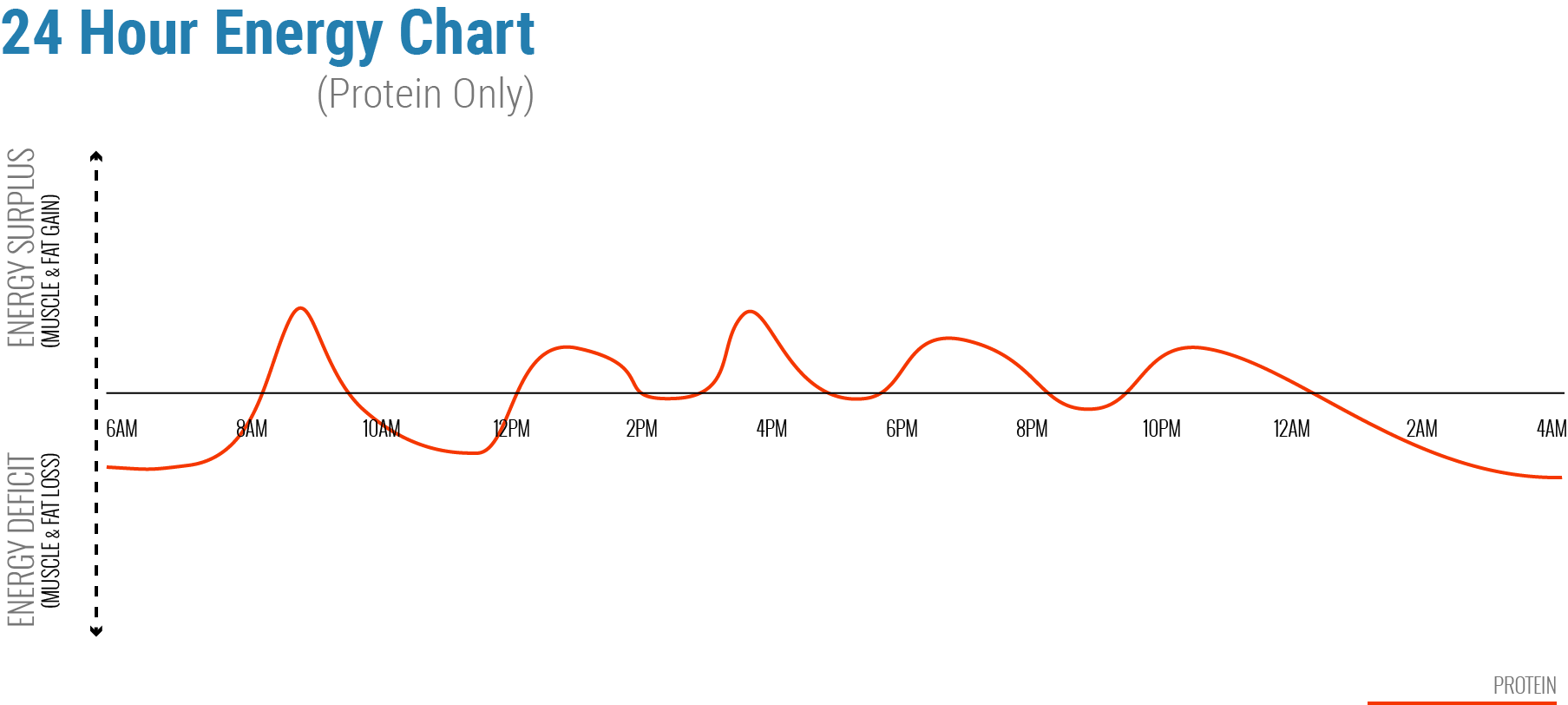
Different proteins are absorbed at different rates and the overall composition of a meal will increase or decrease digestion speed as well (more complex meals = slower digestion); in the graph above, sharper peaks are faster proteins (such as a whey protein shake for breakfast or a mid-afternoon shake) while the flatter plateau-like humps are slower digesting proteins or ones consumed with more complex meals (like lunch and dinner). While it seems like digestion speed should be an important factor, evidence suggests it’s not—the area below the curve is virtually identical regardless of speed, with faster proteins spiking higher and retreating faster and slower proteins spiking lower but persisting for longer. In terms of muscle gain or recovery, these outcomes are equivalent.
Protein Timing Recap
In the big picture, protein timing is important. Being diligent about your protein choices and timing will make a difference long-term in terms of how well you recover and adapt to training. In the short-term, however, there’s little evidence that protein has an acute effect like carbohydrates.
Considering that carbohydrate timing affects both the short- and long-term, this makes protein relatively less of a priority—it’s not unimportant, but you should spend more mental energy getting your carbohydrate timing right than you do for protein. Thankfully, protein timing is relatively easy compared to carbohydrate timing, so this shouldn’t be a problem!
Low-Priority Timing: Fat
Of the three macronutrients, dietary fat is the least important nutrient to consider timing for. Dietary fat is not ergogenic; it doesn’t have any relevant acute effects on exercise at all. Furthermore, our body has vastly more fat in storage than any other macronutrient, meaning there’s always fat available for oxidation regardless of what we’ve eaten in the past few hours.
Another factor at play in dietary fat’s lack of effect on exercise is that fat, whether from diet or storage, requires transport proteins (albumin and chylomicrons) to circulate in the blood. When dietary fat is consumed prior to exercise, there is only minimal impact on total fat oxidation—because the body has limited amounts of transport proteins and they get saturated, so the remaining fat must “wait in line” to enter circulation. Our body’s answer to this problem is to store fat in the muscles where it doesn’t need to enter circulation, and as exercise intensity increases, we use more and more of this intramuscular fat instead.
Our body does keep trying to release free fatty acids into circulation from the adipose tissue, but without sufficient transporters those fatty acids get backed up. After exercise finishes, our body has the time to flush the freed fatty acids from the adipose tissue and uses them to replenish our intramuscular stores. In this way, dietary fat and stored fat do fuel exercise, but only indirectly by replenishing our intramuscular stores afterwards. Timing is unimportant; our body has plenty of adipose tissue to replenish muscle fat stores even in the absence of dietary fat.
There is a modicum of importance when it comes to timing fat, but only insofar as you should avoid consuming meals that cause you gastrointestinal upset before exercise. Some people absorb fat better or worse, and for some a fatty meal can lead to an upset stomach. If this describes you, then avoiding high-fat meals before exercise is a good idea.
Fat can also slow down digestion, but it’s unclear how much this affects exercise. Certainly, a large, heavy meal right before exercise may divert energy towards digestion that would otherwise fuel your muscles—but again, this isn’t as much an issue with fat as is it an overall diet issue. Smaller meals that include fat are probably fine.
Here’s a graph for dietary fat absorption and utilization:
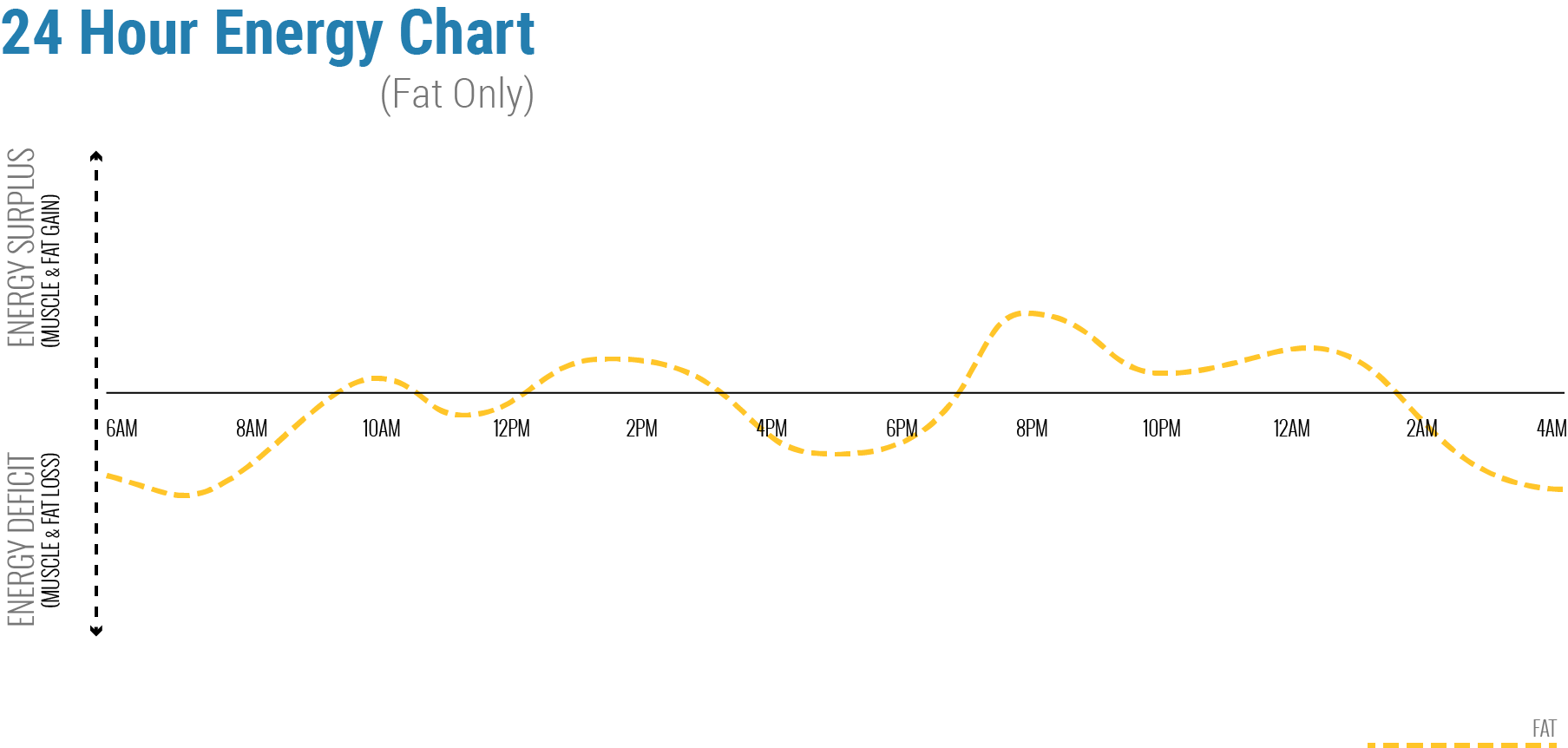
Compared to carbohydrates or proteins, fat is absorbed more slowly and typically remains in circulation for longer—hence the delayed, rounded post-meal energy surplus bumps.
For the record, carbohydrates are absorbed the fastest, with peak blood glucose levels being reached after 30 minutes to an hour. Protein is absorbed more slowly, with “faster” proteins peaking in the plasma after about an hour and slower ones taking around two hours. Fats depend on the total meal capacity more than anything else; small meals may peak after 30 minutes, but a larger meal will see plasma lipids peak after two to three hours.
Given this information, you can glean another reason why dietary fats are less ideal as a fuel for exercise: while carbohydrates can be consumed anywhere from 30 minutes to 2 hours ahead of exercise and affect energy, high-fat meals would need to be consumed hours in advance. During exercise, there is no realistic way to obtain energy from dietary fat.
In the end, there’s no advantage to timing dietary fat except insofar as you must to avoid the normal complications of eating certain foods before exercising. Dietary fat has no ergogenic value since it gets bottlenecked by a lack of transport proteins, so consuming it before exercise accomplishes nothing. Most of the fat that fuels exercise is stored locally in the muscles and only gets replenished after exercise. Superficially, this is similar to our muscle glycogen, except that carbohydrates can also be consumed prior to and during exercise to spare that glycogen or otherwise fuel our workout—something dietary fat is incapable of. For these reasons, fat can be consumed at basically any time and in any amount; do what works for you and your diet.
Special Mention: Alcohol
Alcohol is technically a macronutrient, but it’s also a drug. Someday, I intend to write a comprehensive article on the topic, but there is so much to write about it that I haven’t had the guts to tackle it yet. Here, I’ll only make some cursory suggestions about timing alcohol.
To begin with—and it should be obvious—but don’t drink before or during exercise, especially if you’re engaging in an inherently risky sport such as climbing. Alcohol causes you to lose focus and that not only will inhibit your performance but increase the risk of making life- or limb-threatening mistakes.
As for drinking afterwards, the evidence is a bit murky. Some people adamantly oppose even a single drink, but others have written papers about beer as a recovery fluid. Given the complex effects drugs like alcohol have on our metabolism, I think it’s a smart idea to wait at least a couple hours after exercise before drinking, and to keep total intake low. This is especially true if you’ll be climbing again in the next 12 hours (e.g., if you’re on a climbing trip and will climb again in the morning). That being said, a beer or two after a climbing session probably won’t have as meaningful of an effect on your overall performance as just eating enough carbohydrates would, for example, and relaxing after a hard day of climbing with some friends and alcohol can be pleasant.
If your performance is your primary concern—if you’re trying to complete a project, or are competing—then you might want to avoid alcohol for a few days prior to (and of course during) your trip/event. If you have other reasons for climbing beyond performance (e.g., fun, camaraderie, health, etc.), avoiding alcohol entirely becomes less of a concern.
Concluding Timing
Different macronutrients benefit more or less from timing. The most important of them—carbohydrates—offers an immediate advantage. Protein doesn’t offer any immediate advantage, but in the long-term influences performance. Fat offers no benefit short- or long-term; it’s not an unimportant nutrient, it’s just not one you need to worry about eating in any specific windows.
I know you’ve all been hoping for one final graph with every macronutrient overlaid, so here it is:
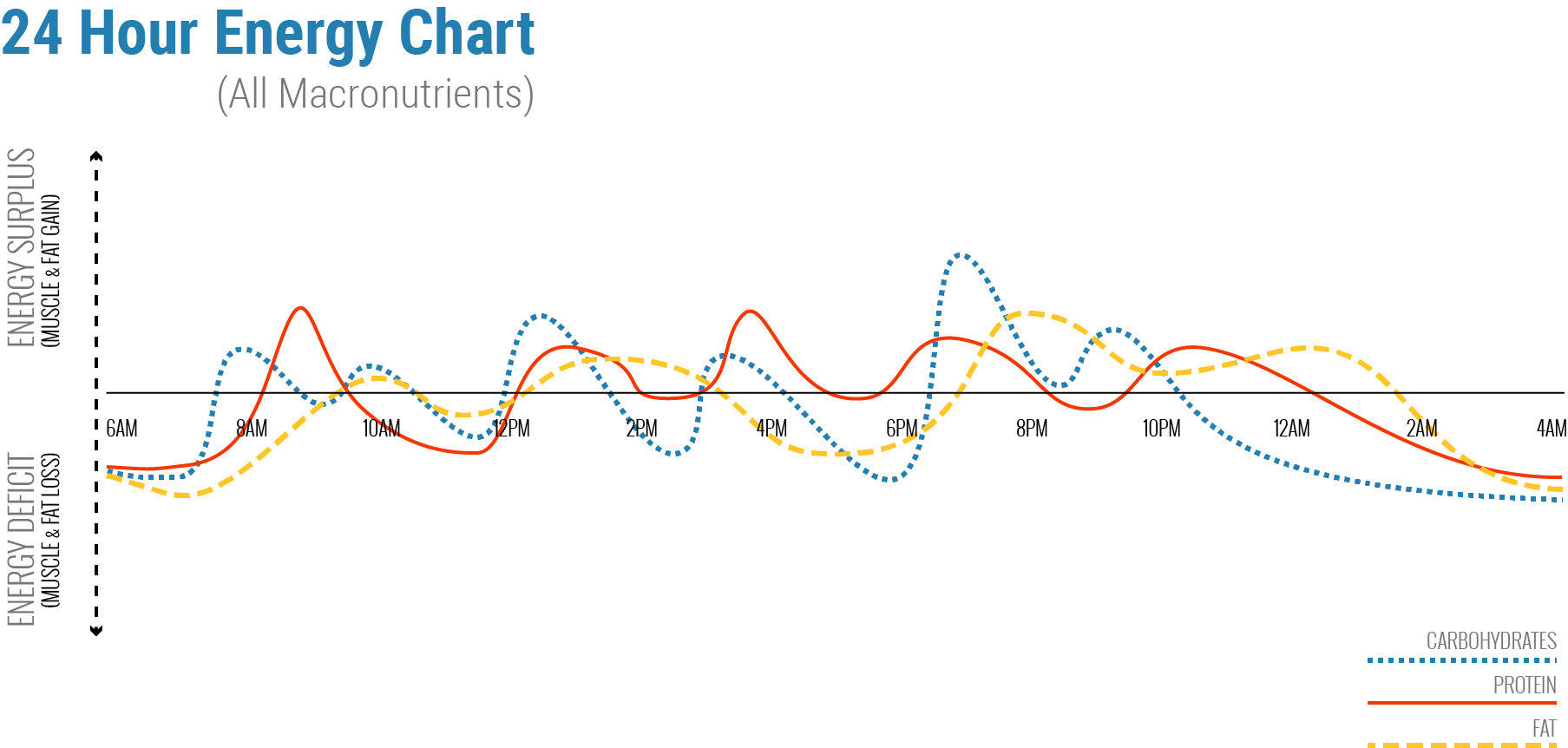
At this point, this graph doesn’t tell us a lot about timing—it’s just for fun! It should also be noted that it’s only representative of what a day might look like and shouldn’t be used for any serious purpose.
Back to timing, the important things to keep in mind are:
- All Carbohydrates Used During Exercise Should Be Replenished. If you don’t compensate for the extra calories—the extra carbohydrates—you burn during exercise, then you will wind up performing poorly, recovering slowly, or burning out. Most of the calories you burn during exercise should be replaced with dietary carbohydrates because carbohydrates are the most flexible macronutrient energy-wise and the only performance-enhancing ones.
- Protein Should Be Spread Out, Not Clustered. I’ve written extensively about this—protein maximally triggers muscle protein synthesis at relatively low amounts (20 grams or so), and extra doesn’t help. Four meals of 20 grams are better than one meal of 100 grams.
- Fat Doesn’t Need to Be Timed, But Is Still Important. Just because fat isn’t ergogenic doesn’t mean it’s not important. Fat should still make up at least 15% of your daily calories, but upwards of 25-35% in most diets. You just don’t need to worry about when you consume it!
Beyond this, there’s not much more to say. Timing matters, some of the time. The rest of the time there’s no benefit!
